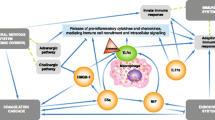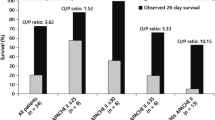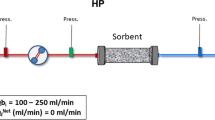Abstract
Background
Severe sepsis and septic shock are perhaps the major cause of morbidity and mortality in Intensive Care. Their pathogenesis is only partly understood. Circulating peptides and lipid-derived substances (so-called mediators), however, appear to participate in the development of organ dysfunction. It might be possible to treat plasma in such a way that the injurious effect of mediators can be attenuated.
Investigations
Several ex vivo studies have shown that it is technically possible to adsorb mediators by means of specially developed sorbents. The application of these sorbents to the treatment of plasma in animals with experimental sepsis has shown that several markers of inflammation can be attenuated and that animal survival can be increased. We have recently transferred such technology to the treatment of human septic shock using a technique called Coupled Plasma Filtration Adsorption (CPFA). CPFA was found to attenuate the hypotension of septic shock and to dramatically alter the immuno-paralytic toxicity of septic plasma. Monocytes of patients treated with CPFA underwent a major improvement in their ability to respond to endotoxin.
Conclusions
CPFA represents a promising new approach to blood purification in sepsis. The findings associated with its application to humans highlight the importance of continuing to investigate blood purification as a possible approach to the treatment of septic shock, the potential usefulness of the humoral theory of sepsis, and the dominant state of immunosuppression associated with established septic shock.


Similar content being viewed by others
References
Camussi G, Montrucchio G, Diminioni L, et al (1995) Septic shock: the unravelling of molecular mechanisms. Nephrol Dial Transplant 10:1808–1813
Pinsky MR (2001) Sepsis: a pro and anti-inflammatory disequilibrium syndrome. Contrib Nephrol 132:354–366
Bellomo R, Ronco C (1998) Indications and criteria for initiating renal replacement therapy in the intensive care unit. Kidney Int 53[Suppl 66]:S106–S109
Liano F, Junco E, Pascual J, Madero R, Verde E, and the Madrid Acute Renal Failure Study Group (1998) The spectrum of acute renal failure in the intensive care unit compared with that seen in other settings. Kidney Int 53[Suppl 66]:S16–S24
Brivet FG, Kleinknecht DJ, Liorat P, Landais PJM (1996) Acute renal failure in intensive care units—causes, outcome, and prognostic factors of hospital mortality: a prospective, multicenter study. Crit Care Med 24:192–198
Morrison DC, Ulevitch RY (1987) The effects of bacterial endotoxin on host mediator system. Am J Pathol 93:527–617
Glauser MP, Zanetti G, Baumgartner JD, Cohen J (1991) Septic shock: pathogenesis. Lancet 338:732–736
Zeni F, Freeman B, Nathanson C (1997) Anti-inflammatory therapies to treat sepsis and septic shock: a reassessment. Crit Care Med 25:1095–1100
Bernard GR, Vincent J-L, Laterre P-F, et al (2001) Efficacy and safety of recombinant human activated protein C for severe sepsis. N Engl J Med 344:699–709
Munoz C, Carlet J, Fitting C, Misset B, Bleriot JP, Cavaillon JM (1991) Dysregulation of in vitro cytokine production by monocytes during sepsis. J Clin Invest 88:1747–1754
Randow F, Syrbe U, Meisel C, Krausch D, Zuckermann H, Platzer C, Volk HD (1995) Mechanism of endotoxin desensitization: involvement of interleukin-10 and transforming growth factor beta. J Exp Med 181:1887–1892
Gutierrez-Ramos JC, Bluethmann H (1997) Molecules and mechanisms operating in septic shock: lessons from knockout mice. Immunol Today 18:329–334
Astiz M, Saha D, Lusader D, Lin R, Rackow E (1996) Monocyte response to bacterial toxins, expression of cell surface receptors, and release of anti-inflammatory cytokines during sepsis. J Lab Clin Med 128:594–600
Wang H, Bloom O, Zhang M, et al (1999) HMG-1 as a late mediator of endotoxin lethality in mice. Science 285:248–251
Fink MP (2001) Cytopathic hypoxia: mitochondrial dysfunction as a mechanism contributing to organ dysfunction in sepsis. Crit Care Clin 17:219–237
Volk HD, Reinke P, Krausch D, Zuckermann H, Asadullah K, Mueller Jm, Doecke WD, Kox WJ (1996) Monocyte deactivation: rationale for a new therapeutic strategy in sepsis. Intensive Care Med[Suppl 4]:S474–481
Brandtzaeg P, Osnes L, Ovstebo R, Joo GB, Westvik A-B, Kierulf P (1996) Net inflammatory capacity of human septic shock plasma evaluated by a monocyte-based target cell assay: identification of interleukin-10 as a major functional deactivator of human monocytes. J Exp Med 184:51–60
Adib-Conquy M, Adrie C, Moine P, Asehnoune K, Fitting C, Pinsky MR, Dhainaut JF, Cavaillon JM (2000) NF-kappaB expression in mononuclear cells of patients with sepsis resembles that observed in lipopolysaccharide tolerance. Am J Respir Crit Care Med 162:1877–1883
Bellomo R, Tipping P, Boyce N (1993) Continuous veno-venous hemofiltration with dialysis removes cytokines from the circulation of septic patients. Crit Care Med 21:522–526
Hoffmann JN, Hartl WH, Deppisch R, Faist E, Jochum M, Inthorn D (1995) Hemofiltration in human sepsis: evidence for elimination of immunomodulatory substances. Kidney Int 48:1563–1570
De Vriese AS, Colardyn FA, Philippe JJ, et al (1999) Cytokine removal during continuous veno-venous hemofiltration in septic patients. J Am Soc Nephrol 10:846–853
De Vriese AS, Vanholder RC, Pascual M, et al (1999) Can inflammatory cytokiens be removed efficiently by continuous renal replacement therapies? Intensive Care Med 25:903–910
Cole L, Bellomo R, Hart G, Journois D, Davenport P, Tipping P, Ronco C (2002) A phase II randomized controlled trial of continuous hemofiltration in sepsis. Crit Care Med 30:100–106
Bellomo R, Baldwin I, Cole L, Ronco C (1998) Preliminary experience with high-volume hemofiltration in human septic shock. Kidney Int 53[Suppl 66]:S182–S185
Ronco C, Bellomo R, Homel P, Brendolan A, Dan M, Piccinni P, La Greca G (2000) Effects of different doses in continuous veno-venous haemofiltration on outcomes of acute renal failure: a prospective randomised trial. Lancet 356:26–30
Honore PM, Jamez J, Wauthier M, et al (2000) Prospective evaluation of short-term high-volume isovolemic hemofiltration on the hemodynamic course and outcome in patients with intractable circulatory failure resulting from septic shock. Crit Care Med 28:3581–3587
Uchino S, Bellomo R, Goldsmith D, Davenport P, Cole L, Baldwin I, Panagiotopoulos S, Tipping P (2002) Super high flux haemofiltration: a new technique for cytokine removal. Intensive Care Med 28:651–655
Reeves JH, Butt WW, Shann F, et al (1999) Continuous plasmafiltration in sepsis syndrome. Crit Care Med 27:2096–2104
Busund R, Koukline V, Utrobin U, Nedashkovsky E (2002) Plasmapheresis in severe sepsis and septic shock: a prospective randomised controlled trial. Intensive Care Med 28:1434–1439
La Greca G, Brendolan A, Ghezzi PM, De Smet R, Tetta C, Gervasio R, Ronco C (1998) The concept of sorbents in hemodialysis. Int J Artif Organs 21:303–308
Doig GS, Martin CM, Sibbald WJ (1997) Polymyxin-dextran antiendotoxin pretreatment in an ovine model of normotensive sepsis. Crit Care Med 25:1956–1961
Lonergan JM, Orlowski JP, Sato T, McHugh MJ, Zborowski M (1994) Extracorporeal endotoxin removal in a canine model of septic shock. ASAIO J 40:M654–M657
Nagaki M, Hughes RD, Lau JYN, Williams R (1991) Removal of endotoxin and cytokines by adsorbents and the effect of plasma protein binding. Int J Artif Organs 14:43–50
Nakamura T, Suzuki Y, Shimada N, Ebihara I, Shoji H, Koide H (1998) Hemoperfusion with polymyxin B-immobilized fiber attenuates the increased plasma levels of thrombomodulin and von Willebrand factor from patients with septic shock. Blood Purif 16:179–186
Sato T, Orlowski JP, Zborowski M (1993) Experimental study of extracorporeal perfusion for septic shock. ASAIO J 39:M790–793
Nakamura T, Ushiyama C, Suzuki S, Shoji H, Shimada N, Ebihara I, Koide H (2000) Polymyxin B-immobilized fiber reduces increased plasma endothelin-1 concentrations in hemodialysis patients with sepsis. Ren Fail 22:225–234
Tetta C, Cavaillon JM, Schulze M, Ronco C, Ghezzi PM, Camussi G, Serra AM, Curti F, Lonnemann G (1988) Removal of cytokines and activated complement components in an experimental model of continuous plasmafiltration coupled with sorbent adsorption. Nephrol Dial Transplant 13:1458–1464
Tetta C, Gianotti L, Cavaillon Jm, Wratten Ml, Fini M, Braga M, Bisagni P, Giavaresi Gl, Bolzani R, Giardino R (2000) Coupled plasmafiltration-adsorption in a rabbit model of endotoxic shock. Crit Care Med 28:1526–1533
Ronco C. Brendolan A, Lonnemann G, Bellomo R, Piccinni P, Digito A, Dan M, Irone M, La Greca G, Inguaggiato P, Maggiore U, De Nitti C, Tetta C (2002) A randomized cross-over study of coupled plasma filtration with adsorption in septic shock. Crit Care Med 30:1250–1255
Author information
Authors and Affiliations
Corresponding author
Rights and permissions
About this article
Cite this article
Bellomo, R., Tetta, C. & Ronco, C. Coupled plasma filtration adsorption. Intensive Care Med 29, 1222–1228 (2003). https://doi.org/10.1007/s00134-003-1796-x
Published:
Issue Date:
DOI: https://doi.org/10.1007/s00134-003-1796-x




